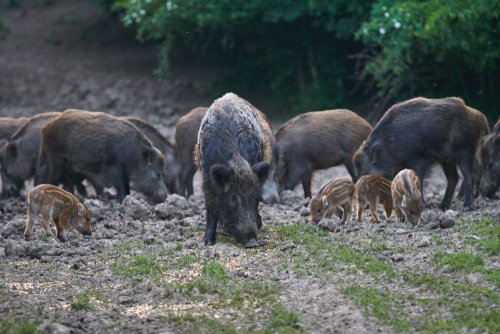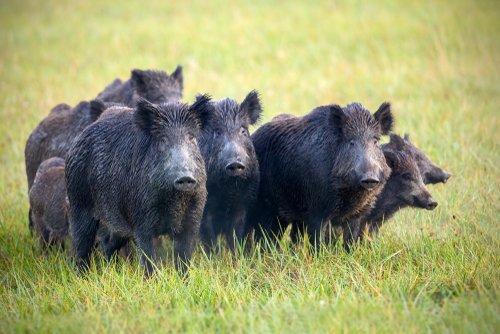Georgia Hog Hunting – Adventures in the Peach State
Georgia hog hunting is an exhilarating and sought-after outdoor pursuit that attracts hunters from all walks of life. With its vast wilderness, diverse ecosystems, and thriving hog population, the state offers a haven for those seeking thrilling adventures in the great outdoors.
Whether an experienced hunter or a novice looking to embark on your first hunting expedition, Georgia provides ample opportunities to test your skills and fulfill your adrenaline-fueled dreams.
Hog hunting in Georgia has gained immense popularity over the years due to several factors. The thrill and excitement of pursuing these intelligent and elusive creatures through dense forests and expansive swamps have captivated many outdoor enthusiasts.
The challenge lies in locating hogs and outsmarting their sharp senses, making it a true test of one’s patience, cunning, and marksmanship. Additionally, hog hunting serves an important conservation purpose in Georgia.
The wild hog population has grown significantly over time due to various factors such as escaped domestic pigs interbreeding with feral hogs or intentional releases for sport hunting. As these invasive species wreak havoc on native habitats and crops, hunting becomes essential for population control efforts.
Brief history of hog population growth and hunting regulations
To understand why hog hunting is so prevalent in Georgia today, it is crucial to delve into its historical context. The introduction of hogs into North America dates back centuries when explorers brought them as food sources during their journeys. Inevitably, some escaped or were released by settlers into the wild.
Over time, these feral hogs thrived due to their adaptability to different environments and rapid breeding rates. This led to a significant increase in population numbers across various states, including Georgia.
Recognizing the need for regulation and management, Georgia established hunting regulations specific to hogs. The state’s Department of Natural Resources implemented measures to control the growing hog population and mitigate the ecological damage caused by these invasive species.
Hunting seasons, bag limits, and specific methods allowed for hog hunting were implemented to balance conservation efforts and recreational hunting. As a result, Georgia has become a prime destination for hunters seeking thrilling hog hunting opportunities while contributing to wildlife management efforts.
Whether you are an avid hunter or an advocate for conservation, hog hunting in Georgia offers adventure and purpose. Stay tuned for the next section as we delve into the fascinating world of wild hog species in Georgia!
The Wild Hog Species in Georgia
Description of the different wild hog species found in Georgia
Georgia has several wild hog species, each with unique characteristics. The most common species in the state is the feral hog, domestic pigs that have escaped or been released into the wild.
These feral hogs come in various colors and sizes, ranging from black and brown to spotted or striped. Another prominent species is the Eurasian boar, known for their thick, bristly coats and distinct tusks.
These boars can be quite large and intimidating, with some reaching weights of over 300 pounds. Additionally, hybrids between domestic pigs and wild boars exhibit a combination of traits from both species.
Discussion on their physical characteristics, behavior, and habitat preferences
Wild hogs in Georgia exhibit diverse physical characteristics depending on their breed and upbringing. Feral hogs often have long snouts and large ears that aid in their keen sense of smell and hearing.
Their bodies are stocky with strong muscles, making them agile runners when alarmed. Eurasian boars typically have thicker fur with bristle-like hair covering their bodies to protect them from harsh weather conditions.
When it comes to behavior, wild hogs are highly adaptable creatures capable of surviving in various habitats throughout Georgia’s diverse landscapes. They are opportunistic omnivores that will eat almost anything, from acorns and roots to insects and small mammals.
They are known for their destructive rooting behavior, tearing up the ground while searching for food. Regarding habitat preference, these resilient creatures thrive in forests, swamps, wetlands, and agricultural fields – anywhere they can find food sources like nuts or crops to scavenge!
They prefer areas with adequate cover, such as dense vegetation or thick undergrowth, where they can hide during the day and rest. Water sources, such as rivers or ponds, are also essential for their survival.
Understanding the physical characteristics, behavior, and habitat preferences of wild hog species in Georgia is crucial for successful hunting expeditions. By gaining insight into their traits and environmental preferences, hunters can better strategize their approaches and increase their chances of a fruitful Georgia hog hunting adventure.
Hunting Methods and Techniques
Spotlighting: Exploring the Art of Hunting Hogs at Night Using Spotlights
Regarding Georgia hog hunting adventures, spotlighting is a technique that adds an extra thrill to the hunt. Picture this: a moonless night, you and your hunting buddies in a truck with powerful spotlights scanning the dark fields. Suddenly, glowing eyes emerge from the shadows – it’s a wild hog!
The adrenaline kicks in as you carefully aim and take your shot. Spotlights help locate hogs in low light conditions and temporarily blind them, making them easier targets.
Dog Hunting: Delving into the Use of Specially Trained Dogs for Tracking and Capturing Hogs
If you want to experience an age-old tradition in Georgia, hog or dog hunting is the way to go. Specially trained dogs, such as Plott Hounds or Catahoulas, are used to track and corner hogs until hunters arrive. These fearless canines possess instincts for tracking scents and are well-versed in maneuvering through thick undergrowth.
Once they’ve located a hog, they’ll emit distinctive barks to alert hunters of its whereabouts. Dog hunting not only enhances efficiency but also adds an element of teamwork between humans and their four-legged companions.
Stalking: Understanding the Stealthy Approach to Hunting Hogs on Foot
For those seeking a more personal connection with nature while hunting hogs in Georgia, stalking is an art worth mastering. This technique involves silent movement through forests or fields while constantly monitoring wind direction and being aware of every rustle or snap that could give away your presence.
Stalking requires patience and skillful navigation around natural obstacles like fallen trees or dense vegetation patches without alarming nearby hogs. It’s an intimate way to experience the wilderness, and successful stalks lead to thrilling close-range encounters with hogs, making it a test of physical and mental prowess.
Equipment and Gear for Hog Hunting in Georgia
Firearms: Taking Aim for the Hunt
Regarding Georgia hog hunting adventures, selecting the right firearm is crucial. Rifles, shotguns, and even handguns can all be effective options.
Rifles are often favored for their accuracy and longer-range capabilities. The .308 Winchester, .30-06 Springfield, and .223 Remington are popular calibers among hog hunters.
These rounds offer excellent stopping power while still providing manageable recoil. On the other hand, shotguns loaded with buckshot can be devastating at close-range encounters with hogs.
Handguns chambered in .357 Magnum or .44 Magnum are also suitable for those who prefer a more compact firearm. Whichever option you choose, ensure you have practiced enough to feel confident in your shooting ability.
Optics: Enhancing Accuracy and Precision
To increase your chances of success during Georgia hog hunting expeditions, consider equipping your firearm with optics such as scopes or red dot sights. Scopes with variable magnification enable hunters to adapt to different shooting distances encountered in various terrains.
Look for scopes with illuminated reticles or low-light settings to aid visibility during dawn or dusk hunts when hogs are most active. Red dot sights provide quick target acquisition by projecting an illuminated dot onto a glass sight window—ideal for rapid shots within close quarters.
Knives: The Ultimate Field Dressing Tool
After a successful hunt in Georgia’s wilds, it’s time to prepare the harvested hogs for consumption. This task demands a high-quality knife designed specifically for field dressing and butchering. When choosing a knife, consider blade length and type carefully.
For field dressing tasks such as skinning or removing entrails, knives with drop point blades excel due to their strong tip and easy maneuverability. Skinning knives with curved blades promote efficient hide removal.
For general-purpose butchering, opt for a sturdy knife with a straight edge for precise slicing, dicing, and deboning. Remember, sharpness is key in ensuring clean and efficient cuts.
Additionally, prioritize durability to handle the demands of processing hogs in rugged hunting environments. Choose a knife that is easy to clean, as hygiene is essential when dealing with game meat.
With the right equipment and gear, your Georgia hog hunting adventures will be safe and successful. Each piece is integral in this thrilling pursuit, from selecting suitable firearms to enhancing accuracy with optics and choosing the perfect knife for field-dressing hogs.
Best Locations for Hog Hunting in Georgia
An Abundance of Wild Hogs: Explore the Prime Regions
Regarding hog hunting in Georgia, several prime locations boast a significant population of these wild beasts. One such area is the renowned Okefenokee Swamp, a sprawling wilderness teeming with hogs waiting for hunters to challenge them. The swamp’s unique ecosystem provides an ideal habitat for these creatures, with its dense vegetation and abundant water sources.
The Chattahoochee National Forest offers another excellent opportunity for hog-hunting enthusiasts. This vast expanse of woodland not only provides ample cover for hogs but presents hunters with breathtaking landscapes and picturesque views.
Hidden Gems: Features and Attractions
Each location has its own set of noteworthy features and attractions that make the hog-hunting experience all the more enticing. Besides encountering wild hogs in Okefenokee Swamp, hunters may stumble upon awe-inspiring bird species like sandhill cranes or observe the elusive American alligator lurking in the swamp’s dark waters.
As for Chattahoochee National Forest, hunters can revel in their pursuit of hogs and take advantage of additional recreational activities available in this natural wonderland. From fishing in sparkling rivers to hiking along scenic trails, there is something to satisfy every adventurer’s heart.
Navigating Lands: Tips for Accessing Hunting Areas
Accessing prime hunting areas is crucial for any Georgia hog hunting adventure. While some regions may be on public lands, it’s important to familiarize yourself with specific regulations and obtain any required permits before venturing out.
Public land access can vary depending on factors such as season and designated zones, so be sure to check with local wildlife management agencies or consult reliable online resources. Alternatively, if you prefer hunting on private lands, establishing connections with landowners who allow hunting can be rewarding.
Networking through local hunting clubs or engaging in respectful communication with landowners may grant you access to exclusive hog hunting territories. Georgia offers an array of prime locations for hog-hunting enthusiasts.
Whether you seek the mysterious allure of the Okefenokee Swamp or the abundant wilderness of Chattahoochee National Forest, each region presents unique features and attractions alongside the thrill of chasing wild hogs. By being mindful of public land regulations and building relationships with private landowners, hunters can embark on memorable Georgia hog hunting adventures while immersing themselves in the beauty of these remarkable landscapes.
Hunting Regulations and Licensing Requirements
Understanding the Hunting Regulations
Before embarking on your thrilling Georgia hog hunting adventure, it’s crucial to grasp the state’s hunting regulations. The Georgia Department of Natural Resources (DNR) oversees hunting activities and sets specific rules to ensure safety and sustainability.
These regulations cover season dates, bag limits, hunting methods, and required licenses. To remain compliant with the regulations, hunters must familiarize themselves with the current guidelines provided by the DNR.
These guidelines are on their official website or obtained from local wildlife management offices. It is essential to review these regulations regularly as they may undergo changes from year to year.
Licensing Requirements for Hog Hunting
When it comes to licensing requirements for hog hunting in Georgia, there are a few things you need to know. Firstly, all hunters must possess a valid Georgia hunting license. This license permits you to hunt on private lands within the state.
Additionally, you will need a separate dog-hunting license if you plan on pursuing hogs with dogs. This ensures that your dogs are trained appropriately and that you follow specific dog-hunting regulations.
It’s important to note that certain age restrictions may apply for obtaining licenses in Georgia. Check with the DNR regarding any age-specific requirements or exceptions before heading out into the field.

Conclusion
As you delve into the world of Georgia hog hunting adventures, remember that it’s not only about thrilling pursuits but also about respecting nature and abiding by regulations for conservation purposes. By following proper licensing requirements and understanding hunting regulations thoroughly, you contribute to preserving this exciting activity for generations to come.
So gear up, embrace nature’s wonders, and immerse yourself in thrilling hunts amidst Georgia’s breathtaking landscapes—it’s an experience that will leave lasting memories and ignite your passion for the outdoors. Happy hunting!






